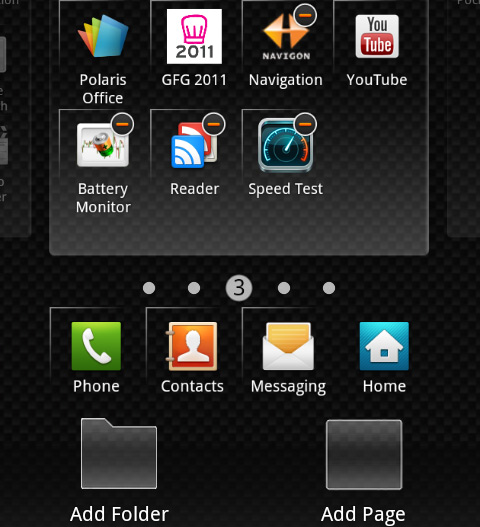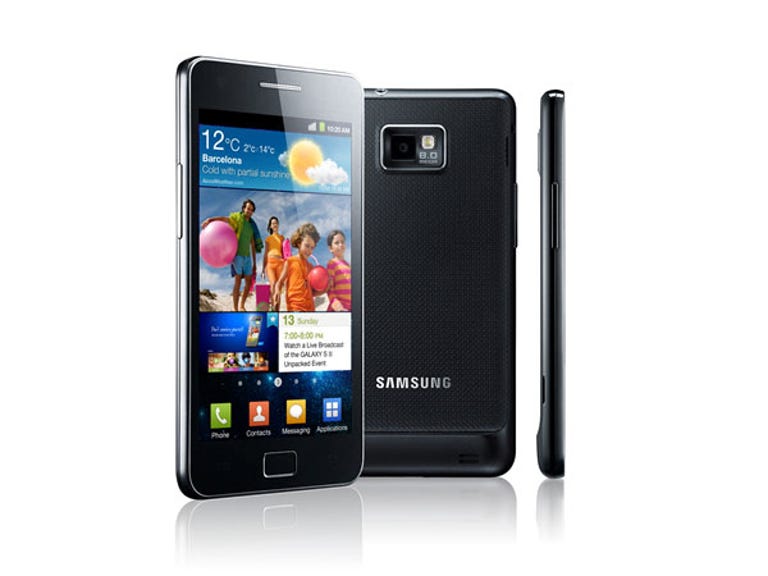 Why You Can Trust CNET
Why You Can Trust CNET Samsung Galaxy S II review: Samsung Galaxy S II
Samsung builds well on the success of the original Galaxy with a fast, attractive and fully featured phone, but one that requires a lot of juice to run.
Design
The response to the physical build of the Galaxy S last year was pretty dismal. Almost everyone we spoke to about the handset commented on its flimsy-feeling plastic construction, though this didn't stop Samsung selling over 20 million of them. This year, it's mostly the same materials in play, but the result is much more appealing. The Galaxy S II (GS2) is still put together with several pieces of black plastic, each with a different texture, but now the overall impression you get is one of a premium quality. The front is glossy and slick, the back is covered in a rough-feeling textured grip and, at only 119 grams, the handset is positively featherweight.
The Good
The Bad
The Bottom Line
The button configuration remains the same as last year, too; a single Home button below the screen with a touch-sensitive button on either side, a volume rocker on the left and a power button on the right. There's an 8-megapixel camera with LED flash on the backside of the GS2 and a 2-megapixel camera on the front for video-calling and pouty self-portraits.
Tying all of these elements together is an outstanding 4.3-inch Super AMOLED Plus display. This is the third generation of Samsung's AMOLED panels, and while the names get longer and sillier, the screens definitely get better. AMOLED panels tend to be darker and richer looking than LCD, so while the whites of an image may appear off-white, the blacks are deep and very nice to look at.
Compared with other smartphones at this time, the GS2 is also impossibly thin, measuring only 8.5mm at its thinnest point. This slimness and its weight offset the large size of the screen, giving the GS2 a great feel in the hand and in your pockets or purse, despite its large footprint.
User experience
Our favourite Android phones this year all have a simplistic approach to the user experience. Sony Ericsson and LG have taken the Android platform and applied a lightweight custom user interface on top. Samsung goes much further, but with similarly pleasing results. This user interface is called TouchWiz 4.0 and while it integrates deeper into the Android system than others, the performance across the user experience is first rate.
The new TouchWiz design is full of noteworthy tweaks and shortcuts, too many to mention here. We love the fast, new navigation across the home screens and app drawer, for example. Simply slide your finger across the home screen panel numbers at the bottom of the screen and you'll zip to the screen you want without having to swipe across them all in order. There's also an array of quick settings toggles in the notifications panel, similar to the Galaxy Tab, and a collection of unique and useful Samsung-designed widgets.

The new editing mode in the TouchWiz app drawer.
(Screenshot by CBSi)
Camera
Not only is the GS2 faster and thinner than the original Galaxy S, we also think its camera stands head and shoulders over its predecessor. The 8-megapixel sensor performs well, even in low light, and the colour reproduction manages to be vibrant without seeming cartoon-like. The HD video recording is also a treat.
The camera handles a mixture of colour temperatures well.
(Credit: CBSi)
Low light photos look great with the Galaxy S II.
(Credit: CBSi)
We love the colour reproduction too, the way bright colours pop without looking cartoony.
(Credit: CBSi)
Bunch 'a hubs
One element present in the Galaxy S II that differentiates Samsung's Android offerings from the rest of the pack is the bonus content and services available through four pre-installed "hubs", particularly the Game Hub and the upcoming Music Hub. Game Hub is split into two sections "Social" and "Premium", and at launch includes 20 titles. The Social games are free to install and play, and include games in the vein of Zynga's FarmVille and Mafia Wars. The Premium titles are supplied by Gameloft, but are demos only. Still, this is a convenient way to try before you buy.
The two faces of Games Hub: Social and Premium.
(Screenshot by CBSi)
The Music Hub has yet to launch in Australia, but will hopefully offer an iTunes-like music discovery and purchasing service on the Galaxy S II. In Europe, the service is powered by 7digital and includes 13 million tracks, though this number could vary substantially after licensing agreements are negotiated locally.
As with previous Galaxy series releases, Samsung also includes Navigon maps as well as Google's free turn-by-turn navigation.
Multimedia
As with the original Galaxy S, the GS2 is a very capable media player. The Samsung Music Player is still probably the best music player produced by the manufacturer (alongside Motorola's) and, though there is no dedicated video player, Samsung does add DivX and XviD video file playback to the basic range of video codecs provided by Android.
If you're hoping to plug your GS2 into a TV, the way you can with the Sony Ericsson Xperia Arc and LG Optimus 2X, the option is there but it's not available out of the box. Samsung has chosen not to use a micro-HDMI port like its competition, but instead the micro-USB port doubles as the video out using a new technology called Mobile High-Definition Link, or MHL. This requires a special MHL HDMI adapter, available at the shop where you bought the GS2, and another standard HDMI cable. Once connected, the MHL connection will mirror your phone's display on your TV or monitor, allowing you to watch videos stored on your SD card or to play Android games on your big screen.
Performance
Without a doubt, the most pleasing aspect of this handset is its flawless performance. Home screen navigation is slick and seamless, application switch is fast, database load times are almost invisible and even if an app kicks the bucket, the GS2 manages to ditch it without sacrificing performance across the rest of the system. The 1GB of RAM seems to help a lot — every time we open the task manager the system has several hundred megabytes of memory in reserve, even with multiple apps running.
Samsung uses a dual-core processor, but opts against the Nvidia Tegra 2 chip we saw in the Motorola Atrix and LG Optimus 2X. Instead it uses a 1.2GHz dual-core chip of its own design — though, it's hard to truly assess whether it is any better or worse without installing the same firmware on either the Moto or the LG. In benchmark tests the Samsung soared, with solid results in JavaScript, processing and 3D rendering tests. The only downside to using its own silicon is that Samsung deprives its users of a number of Tegra 2-specific gaming titles on the Android Market. This is a bit of bummer, but certainly not a deal-breaker.
Battery life
We don't often give battery life its own subheading in our mobile reviews, but it seems pertinent to do so with the GS2. Our review until now has been an outright love-fest, in line with our experience with the handset, though it's not a clean sheet for Samsung this time around. The battery life on the GS2 is a problem, especially for heavy users, and though this is true for most smartphones, the GS2 does appear to drain the juice faster than comparative handsets, sometimes up to twice as fast.
Using an hour of web browsing as our benchmark, the GS2 powered through 20 per cent or more of its available charge in this time frame, while other Androids might use 10 or 15 per cent of charge performing the same task. The end result is a phone you'll either charge during the day or rush home to a power point each evening. Adjusting the screen brightness to one of its lower settings will help, as will switching your connectivity off when it's not being used, but this still doesn't make a big enough difference to mitigate the battery drain for when you are using the phone. To rub salt in the wound, we found it took at least three hours to recharge the phone back to 100 per cent.
An example of a day's battery life showing steep dips over short spaces of time.
(Credit: CBSi)
We also found the handset would get extremely hot during processor-intensive use, like gaming, and especially if we continued to use the phone while it charged. This isn't an uncommon occurrence for smartphones, but it was hot enough and often enough to become irritating during our tests.
Information we've gathered from online forums suggest that the poor battery life could be a symptom of the way Android deals with dual-core processors in version 2.3.3, and that the most recent 2.3.4 firmware fixes the issue. Samsung has committed to releasing a 2.3.4 update for GS2 handsets, so don't be surprised if we bump up the score of this review if it makes a significant difference.
Overall
If we put our concerns about the battery life to one side, this review would conclude by us naming the Galaxy S II as our favourite phone of the year, so far. The combination of the spectacular screen, the slick performance, its connectivity and Samsung's unique content make this a very compelling proposition for anyone on the hunt for a new phone. But we can't overlook the poor battery life, which will frustrate anyone with moderate to high usage patterns. If Samsung can fix this issue with a patch, we'll be glad to amend this review to reflect any significant change in battery life and consider awarding the GS2 an Editors' Choice award. We don't recommend you avoid the GS2 if you're looking for a new phone; in fact, we strongly recommend you take a look when you're in your local phone shop, just be aware of its current limitations.


